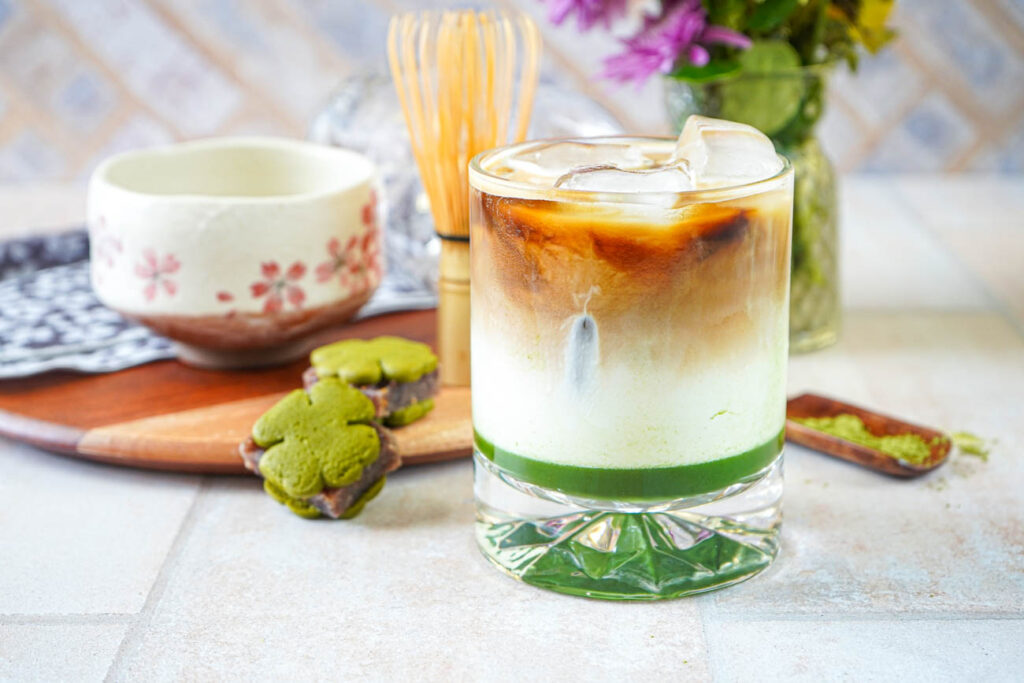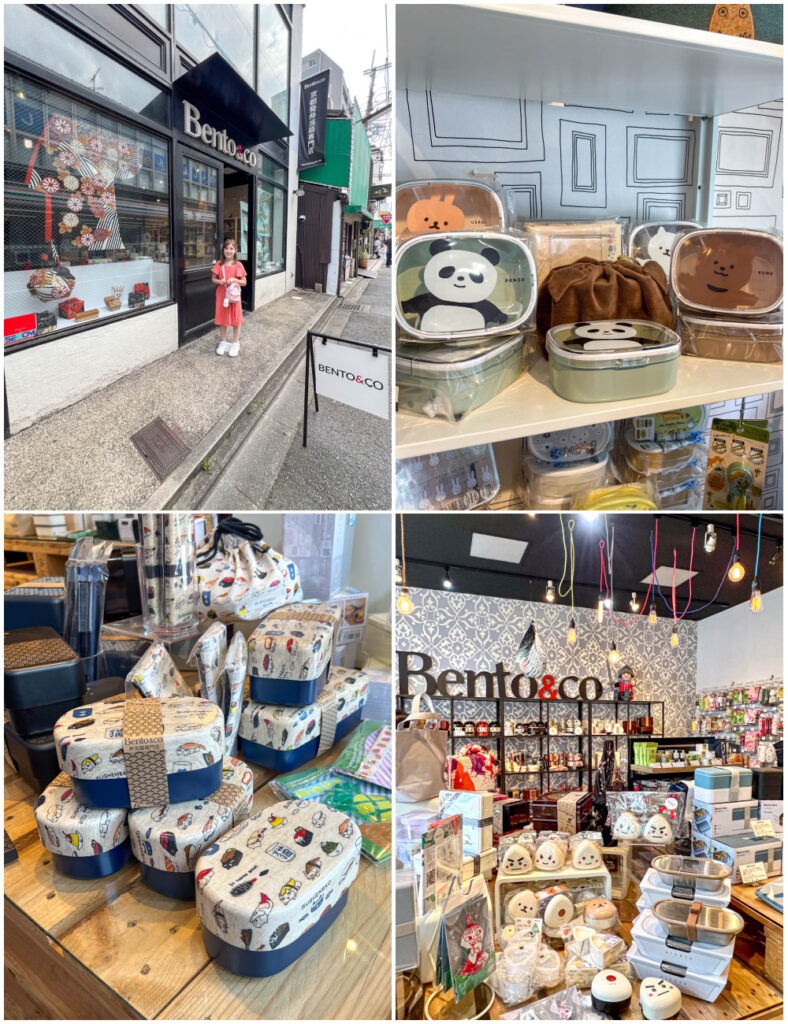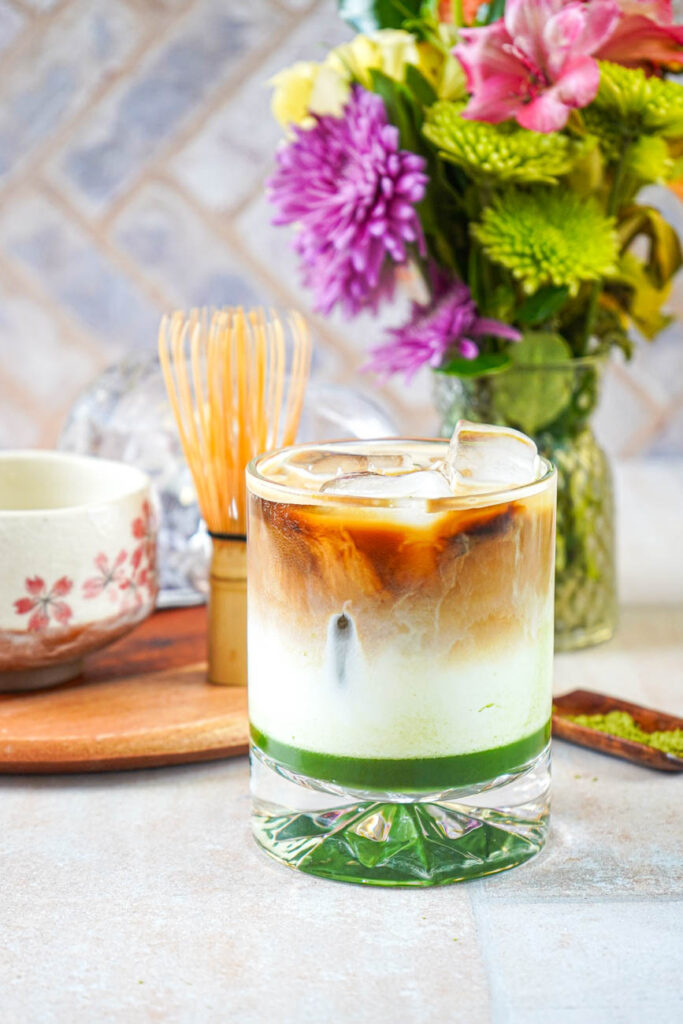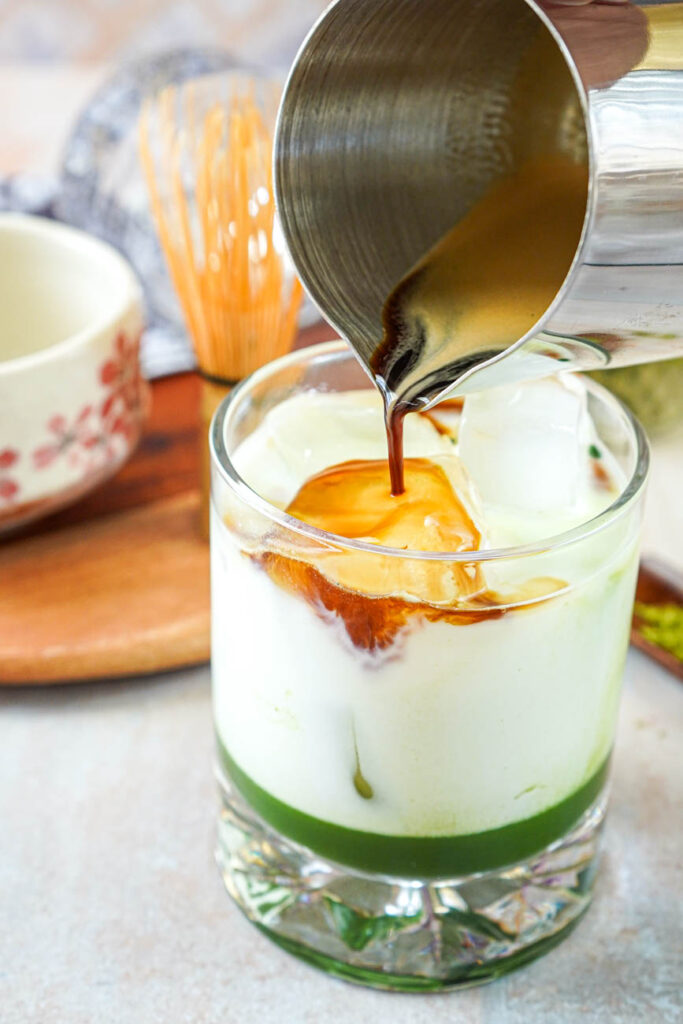A recipe for an Iced Matcha Espresso Latte inspired by our time in Kyoto, Japan! This drink layers matcha with milk and espresso for a refreshing and vibrant blend of flavors.

Over the summer, we were in Japan for a couple of weeks spending time with friends and trying all the incredible food.
I will be covering our travels in a series of posts along with recipes inspired by our experiences. Today, I am sharing our time in the area of Kyoto north of Kyoto Station and a recipe for an Iced Matcha Espresso Latte.
Check out the rest of our travels:
Kyoto

During this trip to Japan, we visited Kyoto for the first time!
Located in the Kansai region, Kyoto (京都) was the capital of Japan from 794 to 1868 and is now home to a beautiful blend of historical buildings and modern architecture along with fantastic food, cultural experiences, and 17 UNESCO World Heritage Sites.
The city is also a great base for day trips to nearby areas such as Osaka, Nara, Uji, Kobe, and more.
We spent six days in Kyoto (with one day in Universal Studios Osaka), but it wasn’t nearly enough time for our relaxed pace. We could have easily stayed longer to see more of the city. For highlights, I recommend at least 3 days.
It was hot during the last week of June and first week of July (with an abnormal lack of rain), averaging around 95-100˚F (35-38˚C) and an even higher heat index due to the humidity. This kept our pace a little slower.
We planned our shrine and temple visits for early morning and generally spent the afternoons indoors. We also used UV umbrellas, hand fans, cooling wipes, and lots of Pocari Sweat (ポカリスエット).
Getting to Kyoto
We arrived in Kyoto via the Tokaido Shinkansen (東海道新幹線) from Shinagawa Station (品川駅, you can also board in Tokyo Station) in Tokyo to Kyoto Station (京都駅).
I booked tickets with seat reservations (highly recommended, especially if not solo and during peak travel days/holidays) using the smartEX App (available in English) and it was easy to have the QR codes on my phone to scan through the gates without any extra steps, lines, or ticket machines.
As a note, the app is only available at the time of this post (2025) to book routes for the Tokaido, Sanyo, and Kyushu Shinkansen lines.
There are three types of Shinkansen on this track from fastest to slowest: Nozomi (limited stops- a little over 2 hours), Hikari (a few more stops, about 2 1/2 hours), and Kodama (stops at all the stations along the line, 3 1/2 hours).
From Shin-Osaka Station (新大阪駅), the Tokaido-Sanyo Line takes about 30 minutes to reach Kyoto Station.
From Kansai International Airport (関西国際空港, KIX), Kyoto Station is about 70 minutes via the JR Haruka Limited Express or 1 1/2 hours via the Limousine Bus.
For most of the areas featured in this post, I either walked from Kyoto Station, took the bus, or took the subway (Karasuma Line, 烏丸線).
Tsumugi Cafe

One morning before going to Kinkaku-ji, I stopped by Tsumugi Cafe. This bright and relaxed cafe is a short walk northeast of Kyoto Station and features coffee, tea, other specialty drinks, cheesecake, and toast.
I enjoyed the following:
- グリーンティーラテプレッソ – Green Tea Latte Presso. I got the hot version, but there is also a layered iced version with matcha, then milk, and espresso on top.
- バスクチーズケーキ – Burnt Basque Cheesecake. The texture was wonderful and I loved the pairing with the salt.
Nintendo Kyoto

To take a break from the heat, we stopped by the Nintendo Store at the top level (7F) of Kyoto Takashimaya Shopping in Shimogyo Ward twice during our trip.
The store features Nintendo-themed toys, clothing, stationery, kitchenware, snacks, and more in a vibrant space. The Nintendo Switch 2 was also released a couple of weeks before our visit, so the family loved being able to try Mario Kart World and see the new games.

We have visited other Nintendo Stores in New York City and Tokyo, but a unique feature at this location is the rooftop! There is a photo spot with Mario and a store associate was there to assist in taking pictures.
It can be difficult to get photos of the four of us while traveling, so I especially appreciated this.
Lina Stores Kyoto Takashimaya

While Claire and I left to get parfaits, Chad and Evan stayed in Takashimaya to enjoy some pasta for lunch from Lina Stores on the ground level just inside the Shijo-Dori (四条通) entrance.
In addition to Kyoto, Lina Stores has locations in Tokyo (Muromachi and Omotesando). They have focused on fresh pasta since 1944 along with drinks, appetizers, and desserts.
Chad ordered a Negroni (ネグローニ) and Carbonara (カルボナーラ), while Evan picked the Tagliatelle alla Bolognese (牛ひき肉のボロネーゼ タリアテッレ).
Karafuneya Coffee

While researching for the trip, Claire immediately added Karafuneya Coffee to the list after learning the menu at their main store in Nakagyo Ward has roughly 150 different parfait options.
Karafuneya Coffee (からふね屋珈琲店) was founded in Kyoto in 1972 and now has 11 stores in Kyoto and Osaka featuring parfaits and other sweet and savory menu items.
It was quite difficult to narrow down (I recommend looking at the menu online ahead of time), but we ultimately decided on the Espresso Coffee and Soft Serve Parfait (エスプレッソコーヒーソフトパフェ) and Strawberry and Milk Parfait (いちごみるくパフェ).
Bento&co

After featuring Bento&co a few years ago in my Winnie the Pooh Bento, Cat Bento, and Star Wars Bento recipes, I was so excited to see the shop in person!
Bento&co’s brick and mortar store opened in Kyoto in 2012 and is Japan’s first specialty bento box shop. They are situated in Nakagyo Ward just a couple of blocks north of Nishiki Market.
The shop is filled with an assortment of bento boxes, furoshiki, and accessories in a beautifully styled space.
Nishiki Market

One block north of Shijo-Dori, Nishiki Market (錦市場, Nishiki Ichiba) in Nakagyo Ward is a food lover’s dream. This long, covered street stretches from Takakura-Dori (高倉通) to Teramachi-Dori (寺町通) and is filled with over 100 stalls.
Its history dates back hundreds of years from estimations of a market existing in the area during the 8th century and the opening of shops in 1310 to the recognition of three fish wholesalers (Kami-no-Tana, the Nishiki-no-tana, and the Rokujo-no-tana) in 1615.
The stalls now have everything from regional specialties and street food to tableware, souvenirs, and small restaurants.

Hours for Nishiki Market are generally 10:00 to 18:00 daily. We visited later in the afternoon, around 4 pm, and the crowds were a lot lower as some of the stalls were starting to close. The peak times are often around lunchtime and early afternoon.
To reach the market, we took the Karasuma Line from Kyoto Station to Shijo Station (四条駅), then walked about 450 meters (1/4 mile) to the west entrance.

During our visit, I picked up a bag of Five Color Arare (五色あられ) at Shimamoto-Nori-Kanbutu (島本海苔乾物). This shop specializes in nori, kombu, bonito flakes, furikake, and other dried products.
Another favorite spot was Kitchen Yuzen (きっちん遊膳). This specialty store focuses on chopsticks, but my personally favorite was looking through the wonderful variety of chopstick rests (箸置き) in all sorts of fun themes.
I took home a toast-shaped chopstick rest while Claire got one highlighting Kyoto candy (京の飴ちゃん). There is also an assortment of glassware and tableware.
Snoopy Cha-Ya

As we were walking through the market, Claire was drawn to Snoopy Cha-Ya with all the treats in the window.
Snoopy Cha-Ya is a fun shop with a variety of Snoopy-themed treats and merchandise. Desserts and drinks are available to order for dine in or take out on the first floor with tables and a second sweets area on the second floor. There are additional locations across Japan.
We originally planned to get the Snoopy Yaki (Taiyaki shaped like Snoopy), but then decided on the shave ice instead to cool off a bit:
- かき氷パフェ – Shaved Ice Parfait with Belle Marshmallow, Kakigori, Strawberry Milk, Red Bean, Jelly, and Shiratama Dango.
- スヌーピーマシュマロドリンク – Snoopy Marshmallow Drink. Different versions were available. I picked the iced matcha latte.
Higashiyama District

In Eastern Kyoto, Higashiyama District (東山区) is a historic and picturesque area featuring narrow stone paths lined with traditional wooden buildings (Machiya, 町家), restaurants, cafes, temples, shrines, and teahouses. It is also home to the especially popular Gion (祇園) district.
From Kyoto Station, the 206 City Bus takes around 12 minutes and 8 stops to get to the Kiyomizumichi bus stop. As a note, the lines to get on the buses often become long during peak hours.

As we walked through the area, Yasaka Pagoda (八坂の塔) dominated the view.
This 46 meter (151 foot), five-level pagoda was originally built in the 6th or 7th century (I found conflicting information), then rebuilt in 1440 following a fire. It is the only remaining structure of the Hōkan-ji (法観寺) complex.

Starbucks Coffee – Kyoto Nineizaka Yasaka Chaya

While in the Higashiyama District, Claire requested we stop by Starbucks Coffee – Kyoto Nineizaka Yasaka Chaya (スターバックスコーヒー 京都二寧坂ヤサカ茶屋店).
This unique location is housed in a 100 year old Machiya and blends in with the surrounding area.

We arrived about 15 minutes before opening and there was already a line. We were escorted to the seating area first (since we were towards the end of the line, most of the seats had already been taken so we split up 2 x 2), then I went back downstairs to order.
I ordered at the counter, picked up the food items, then went to separate bar area for the drinks.
The seating area on the second level has three tatami rooms (take shoes off before entering) along with bench and table seating.

Most of the menu is the same as other Starbucks in Japan. This location was actually celebrating their 8th anniversary on the day of our visit (June 30th).
For the anniversary, they were highlighting their Matcha Cream Frappuccino (抹茶 クリーム フラペチーノ). We also got the Bitter Cream Coffee (ビター クリーム コーヒー), Sugar Donut (シュガードーナツ), and Arabiki Sausage Pie (あらびきソーセージパイ).
Kiyomizu-Dera

After breakfast at Starbucks, we walked about 450 meters (1/4 mile) to Kiyomizu-Dera (清水寺).
This Buddhist temple was founded in 778 and became a UNESCO World Heritage Site in 1994 as a part of “Historic Monuments of Ancient Kyoto.” It is dedicated to Kannon, the Buddhist Goddess of Mercy.
The temple rests halfway up Mount Otowa and offers sweeping views of the city below.

The Main Hall (Hondo, 本堂) and its 13 meter (43 ft) high wooden stage was built in 1633 and showcases the incredible craftsmanship without the use of a single nail.
To visit the Main Hall, tickets are required and can be purchased at the counter just before the building. As a note, it is cash only.

Other notable buildings include the 31 meter (102 ft) high three level pagoda, the vibrant Bell Tower (built in 1596 and restored in 1999), Jishu Shrine, and the Otowa Waterfall at the base of the main hall.
During our visit, the temple was open from 6 am to 6 pm. We arrived around 9 am and the area was already starting to get busy with larger groups and crowds. Check the official Kiyomizu-dera website for current hours before visiting.
Imamiya Jinja Shrine

Further to the west, Imamiya Jinja Shrine is located in Kita-ku (北区). I personally took the Karasuma Line (Subway) from Kyoto Station to Kitaoji Station (北大路駅), then the 206 City Bus (there were directions on the floor from the subway to the correct bus stop) to the Funaokayama stop. From there, it was a 500 meter (1/3 mile) walk north to the shrine.
Another option is to take the 206 City Bus directly from Kyoto Station to Funaokayama. It is roughly 21 stops/38 minutes. The buses often made me feel a little claustrophobic, so I took the subway as much as possible.

Imamiya Jinja (今宮神社) dates back to the Heian period in 994, but the location was moved in 1001 and the current structures were built in 1902.
It is home to festivals throughout the year including the Yasurai festival in April.
Ichimonjiya Wasuke

Just outside to the east entrance of Imamiya Shrine is Ichimonjiya Wasuke (一文字屋和輔, Ichiwa).
This confectionery shop first opened in the year 1000 and is currently run by the 25th generation of the same family! Over the last 1,000+ years, they have sold Aburi-Mochi (あぶり餅)- skewered rice cakes coated in kinako (roasted soybean flour), cooked over charcoal, and paired with a sweet white miso sauce.

You can enjoy the skewers served with tea at tables with tatami seating or order three sets for take away.
I recommend eating on site. The atmosphere is just incredible. Remember to take off your shoes before entering the tatami room and grab a cushion before sitting.

At the time of this post (2025), they are cash only and closed every Wednesday.
Kinkaku-ji

For my final morning in Kyoto, I went alone to Kinkaku-ji (金閣寺, The Golden Pavilion) in Kita-ku (北区). Officially named Rokuon-ji (鹿苑寺), this temple was built originally as the residence of retiring Shogun Ashikaga Yoshimitsu in 1397.
It was transitioned into a Rinzai-sect Zen Temple following his death and designated a UNESCO World Heritage Site in 1994. The location is absolutely gorgeous with the surrounding pond (鏡湖池/Mirror Pond, love the reflection of the gold leaf in the water) and trees.

Right at opening (9 am), there were a few people but it wasn’t overwhelming and the paths were easy to navigate. I saw tour buses starting to park as I was leaving about an hour later.
Tickets are required to enter and are available at the counter before the gates (cash only). You can walk along the designated paths, but the inside of the building is not open to the public to preserve the relics within.

To get to Kinkaku-ji from Kyoto Station, take the Karasuma Line (Subway) to Kitaoji Station (北大路駅). After getting off the subway, take a look at the floor. There are color-coded paths marked for each of the buses with one specifically for Kinkaku-ji (Kinkakuji-michi stop).
From the bus stop, it is a 200 meter (656 ft) walk to the grounds. It is also only a couple of bus stops from the previously mentioned Imamiya-Jinja Shrine.
Iced Matcha Espresso Latte

During our last trip to Japan, I shared a recipe for a Matcha Latte inspired by our time in Shinjuku, Tokyo. This time, I am taking the drink a step further with an Iced Matcha Espresso Latte inspired by my visit to Tsumugi Cafe.
This matcha espresso fusion drink has many names from Iced Matcha Espresso Latte to Dirty Matcha Latte and Camo Latte. I even came across the drink labeled “The Incredible Hulk” at ChitChat in Los Angeles.
Regardless of the name, this vibrant, layered drink is a great option if you just can’t decide between coffee or tea.
The best part of making it at home is that you can also adjust the ingredients more or less based on personal preference. The ratios I have shown in this recipe are a starting point and how I generally enjoy it.
Matcha
Matcha is a powder created by grinding whole green tea leaves. I have been able to find it in markets with Japanese ingredients and more recently in the tea section of larger grocery stores.
Be careful when storing matcha. It can become stale and brownish when exposed to oxygen.
A Few Iced Matcha Espresso Latte Tips

I prepared the drink iced at home, but it can also be made into a hot drink as I enjoyed at Tsumugi Cafe. There just won’t be distinct layers.
For a hot option, simply omit the ice and use frothed, hot milk.
In the photos, I assembled the Iced Matcha Espresso Latte in a 12 ounce (355 milliliter) glass.
For best results, use a Chasen (茶筅, bamboo whisk) and Chawan (茶碗, tea bowl) for blending the matcha into the hot water (65-80˚C/150-175˚F). I currently have only a round Chawan, but one with a small spout would be very helpful to transfer to the serving glass. If you do not have a bamboo whisk, use a handheld milk frother or metal whisk.
Sift the matcha through a fine mesh sieve before blending with the hot water. This will help create a more smooth drink. Make sure the water isn’t too hot or it will develop a more bitter flavor.
I used my homemade vanilla syrup to sweeten the drink. You can swap based on personal preference for another sweetener such as maple syrup or honey if desired. Just do not omit the sugar. That is what creates the distinct layer between the matcha and the milk.
Pour the cold milk slowly over the back of a spoon to keep the layers separated.
The espresso/strongly brewed coffee needs to be warm and also poured slowly to settle over the cold milk.
For a non-dairy option, use oat or almond milk.

Iced Matcha Espresso Latte Recipe
Adapted from The Japanese Larder
Iced Matcha Espresso Latte
Ingredients
- 1 teaspoon matcha green tea powder, sifted
- 2 tablespoons (30 milliliters) hot water not boiling, (65-80˚C/150-175˚F)
- 1 tablespoon (15 milliliters) vanilla syrup or honey
- 1/2 cup (120 milliliters) cold milk dairy or non-dairy
- 1/4 cup (60 milliliters) fresh espresso or strongly brewed coffee warm
Instructions
- In a small bowl, whisk the sifted matcha with the hot water until completely dissolved and smooth with no clumps remaining.
- Whisk in the vanilla syrup or honey.
- Pour the matcha mixture into a heat-safe glass.
- Add ice cubes to the glass.
- Slowly pour the milk over an ice cubes into the glass to form a layer over the matcha.
- Slowly pour the warm espresso over an ice cube into the glass to form a layer over the milk.
- Stir and serve immediately.




Leave a Reply